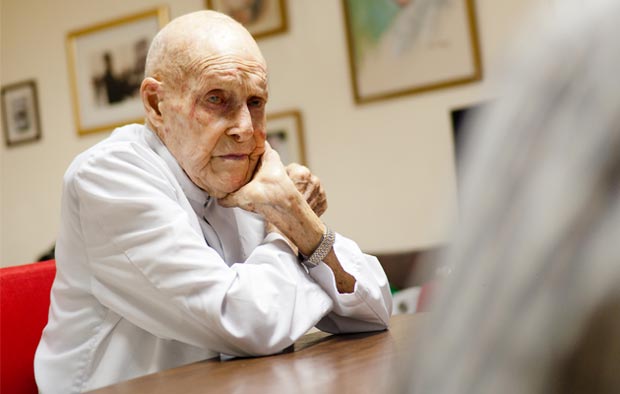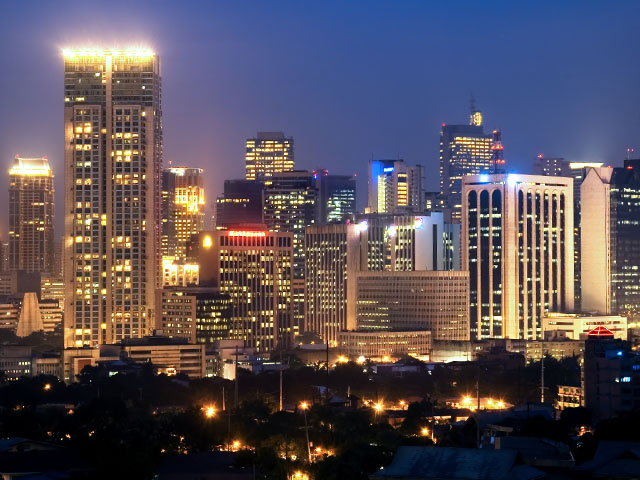One faded away and left a legacy of laughs, while another departed abruptly, tragically, leaving a shining moral example. They came from the fields of arts, politics, and media, and their exits made news in 2012.
We remember the ways they changed the country, in the order in which they left us in 2012.
1. Iggy Arroyo
July 15, 1951 - January 26, 2012
Iggy Arroyo, former Congressman of Negros Occidental and younger brother of former First Gentleman Mike Arroyo, passed away in London, where he was receiving treatment for his liver ailment.
Iggy Arroyo became widely known in 2003 when the controversy erupted over the multi-million peso Jose Pidal account, believed to be owned by the former First Gentleman. At a court hearing, Iggy claimed, to the disbelief of many, that he owned the account.
2. Benjamin Romualdez
September 24, 1930 – February 21, 2012
Benjamin “Kokoy” Romualdez, former Governor of Leyte and younger brother of former First Lady Imelda Marcos, died of cancer.
During the Marcos regime, Romualdez was appointed ambassador to China, Saudi Arabia and the United States while serving as Leyte governor.
He was also involved in running a slew of companies, banks and utilities seized by the Marcos regime during martial law. He tended to use his influence quietly and without fanfare while his older sister Imelda became a flamboyant international symbol of excess, a previous report said.
3. Horacio Morales
September 11, 1943 – February 29, 2012
Former activist and Agrarian Reform Secretary Horacio "Boy" Morales Jr. died two months after suffering a heart attack while playing golf in Baguio City.
Morales was former President Joseph Estrada ’s campaign strategist and agrarian reform secretary.
He joined the Communist Party of the Philippines in the 1970s and became an active member of the underground movement until his arrest in 1982. He ran for senator shortly after the EDSA-1 People Power revolution but lost in the election.
"RIP (rest in peace), our friend Boy Morales, nakasama namin sa paglaban kay GMA (Gloria Macapagal-Arroyo)," Bagong Alyansang Makabayan secretary-general Renato Reyes Jr. said on Twitter.
4. Isagani Yambot
November 16, 1934 – March 2, 2012
Isagani Yambot, veteran Philippine newsman and publisher of Philippine Daily Inquirer, died of a heart attack.
Yambot became publisher of the Inquirer in 1994. Even outside his organization, Yambot was a respected media leader.
After witnessing many changes in media during his career, Yambot never failed to remind younger journalists that while the tools of the trade have evolved, the profession's bedrock values were timeless: truthfulness, fairness, non-partisanship, courage.
"We believe it is no exaggeration to say the entire fourth estate wished Isagani Yambot well, as he underwent cardiac bypass surgery. It has come as a profound shock to hear his bereaved family announce his passing. He writes 30 at a time when the newspaper he had worked with for so long, was enjoying unparalleled public trust and popularity," deputy presidential spokesperson Abigail Valte said in a Palace statement.
"He was a calm, cheerful presence not only in the newsroom and boardroom of his paper, but in every gathering of note among journalists and between media, civil society, and government. His was a voice of passion yet reason; the loss of his presence will be felt deeply by a nation that knows all a newsman can ask for, in the end, is this simple epitaph: he wrote it, as he saw it, with honest words and with his only master, the truth," Valte concluded.
5. Luis Gonzales
August 8, 1928 – March 15, 2012
Luis Gonzales, a stalwart of Sampaguita Pictures, died of pneumonia.
Gonzales had appeared in films opposite Gloria Romero and the late Nida Blanca (Dorothy Jones).
He was a versatile actor, appearing in action, comedy, drama, musical and romance films in the 1950s and 1960s. Among the films he starred in were “Bumunot Ka't Lumaban” (1964), “Colegiala” (1957), “Nagkita si Kerubin at Tulisang Pugot” (1954), “Just Married, Do Not Disturb” (1972) and “Winter Holiday” (1972).
6. Angelo Castro, Jr.
March 6, 1945 – April 5, 2012
Veteran broadcast journalist Angelo Castro Jr. passed away after battling lung cancer for several years. Castro was a longtime news anchor at ABS-CBN, and was seen on the late evening news as the main anchor of the news program The World Tonight.
In a statement posted on the government's website, presidential spokesperson Edwin Lacierda said: "We mourn the passing of Angelo Castro Jr. For many years he was a calm and reassuring presence on the late evening news. His passing marks the closing of an era of gentlemanly broadcasting, where erudition and dignity were the hallmarks of news and current affairs."
"Castro joined ABS-CBN in 1986 when it re-opened after the EDSA revolution. Since that time, ACJ has been our boss, mentor, top anchor, colleague, friend and leader in many ways," ANC said in a statement posted on the network's news website.
7. Mario O'Hara
April 20, 1946 – died 26 June 2012
Mario O'Hara, award-winning director, died of leukemia. He was known for his films “Tatlong Taong Walang Diyos” (1976), “Condemned” (1984), “Bulaklak ng City Jail” (1984), and “Babae sa Breakwater” (2003).
He was also known for writing award-winning screenplays such as “Tinimbang Ka Ngunit Kulang” (1974) and “Insiang” (1976), directed by National Artist for Film Lino Brocka. His final film was the 2010 Cinemalaya film, “Ang Paglilitis ni Andres Bonifacio,” which featured Alfred Vargas as the Supremo.
He also wrote“Stage Show,” a musical in Tanghalang Pilipino's 26th season.

King of Comedy Dolphy
Photo courtesy of the Cultural Center of the Philippines
Photo courtesy of the Cultural Center of the Philippines
July 25, 1928 – July 10, 2012
"King of Comedy" Rodolfo Vera Quizon died of chronic obstructive pulmonary disease and multiple organ failure.
Dolphy starred in over 200 movies, including several reprising his lovable lead character in John en Marsha, a popular, long-running television show.
Dolphy is also famous for playing gay characters in movies like “Facifica Falayfay” (1969), “Fefita Fofongay, Sarhento Fofongay” (1973), “A... Ewan” (Oh…I Don’t Know) (1974), “Ang Tatay Kong Nanay” (My Dad The Mom) (1978), and “Markova: Comfort Gay” (2001).
Dolphy received his FAMAS Best Actor award in 1978 for his role in the movie “Omeng Satanasia,” which was produced by RVQ Productions.
For their roles in “Markova: Comfort Gay”, Dolphy and his children Eric and Jeffrey Quizon received the Prix de la Meilleure Interpretation award – the equivalent of a Best Actor Award – in Brussels, Belgium.

Jesse Robredo Photo by Anna Mae Lamentillo
May 27, 1958 – August 18, 2012
Jesse Robredo, former Interior and Local Government Secretary, died in a plane crash off Masbate. Robredo was known as a good governance guru and ideal family man. He was a Dangal ng Bayan awardee, the highest government award given to government officials or employees for exemplary public service.
“The most important ingredient of leadership is character. Most of the proficiencies can be learned, but what's inside you is something that's difficult to change,” Robredo once said in a television documentary.
When he was appointed as DILG secretary in 2010, Robredo drummed up public support for the Full Disclosure Policy, which required local government units to disclose in public places the 12 key financial documents that show how their funds are spent.
"Hindi rin sapat na tayo ay mahusay lamang. Hindi lahat ng matino ay mahusay, at lalo namang hindi lahat ng mahusay ay matino,” he was fond of telling colleagues, according to the DILG website. “Ang dapat ay matino at mahusay upang karapat-dapat tayong pagkatiwalaan ng pera ng bayan.”
10. Jun 'Bote' Bautista
1939 - September 25, 2012
Veteran television reporter Augurio Bautista Camu Jr., died after a long battle with chronic obstructive pulmonary disease.
Known as Jun Bautista in the media, he fit the image of the hard-nosed, irreverent reporter. "Walang sinasanto," was how one colleague remembered him.
He covered the Senate for years and was known for his professionalism, sharp news sense, and geniality. He was named Reporter of the Year in 1997 by the Rotary Club of Manila.

Director Marilou Diaz-Abaya Photo by Wig Tysmans
March 30, 1955 – October 8, 2012
Multi-awarded film director Marilou Diaz-Abayapassed away after a long battle with breast cancer.
Among Abaya's critically acclaimed movies was “Jose Rizal” (1998), which won numerous awards in that year's Metro Manila Film Festival, including Best Picture. She also directed other notable Filipino movies like “Karnal” (1983) and “Muro-ami” (1999).
Abaya had won numerous directing awards from award-giving bodies such as the Metro Manila Film Festival, the Urian Awards, the Film Academy of the Philippines, the FAMAS Awards, the Star Awards, the Catholic Mass Media Awards, the British Film Institute Award, the International Federation of Film Critics Award, and the Network of Pan Asian Cinema Award.
She was also founder and president of Marilou Diaz-Abaya Film Institute and Arts Center.
12. Celso Ad Castillo
September 12, 1943 - November 26, 2012
Celso Ad Castillo, the "enfant terrible" of Philippine cinema, died of a heart attack in his house in Siniloan in Laguna province.
"Everything has shown beauty, only not everyone sees it. But I see it. That's a gift. I'm pretty secure, my place in Philippine cinema," Castillo once said on Showbiz Exclusives.
"Si Celso, artist talaga in the real sense of the word, dahil ‘pag nagshoo-shoot, kung minsan he gets so carried away... Innovator siya eh, marami siyang mga ideas na ahead of his time," said entertainment writer Ricky Lo.
Castillo was recognized as Best Director for several of his films, such as “Ang Alamat ni Julian Makabayan,” “Pag-puti ng Uwak, Pag-itim ng Tagak,” “Burlesk Queen,” “Paradise Inn,” and “Itlog”).
He received the FAP Lifetime Achievement Award and the FAMAS Lifetime Achievement Award in 2007.
Castillo also taught at the Asia Pacific Film Institute, and wrote "Celso Ad Castillo: An Autobiography and his Craft."
13. Romeo Capulong
February 15, 1935 - September 16, 2012
Romeo Capulong, human rights lawyer, died of cardiac arrest.
Capulong founded the Filipino Lawyers Committee for Human Rights in New York in 1980, and the Philippine center for Immigrant Rights in 1985.
From 1960 to 1969, he served as provincial secretary and confidential assistant of Gov. Eduardo Joson in Nueva Ecija.
A curriculum vitae at the United Nations showed Capulong sought and was granted political asylum in the United States in 1980. He returned to the Philippines and resumed law practice in 1986.
He founded the Public Interest Law Center in Manila in 1989, and the Philippine Peace Center in Manila also in 1989.
Capulong had fought for the rights of Flor Contemplacion, an overseas Filipino worker executed in 1995 for the killing of her ward.
In the impeachment trial of former President Joseph Estrada, Bagong Alyansang Makabayan secretary general Renato Reyes Jr. said Capulong would provide important legal inputs. He also led the walkout of private prosecutors when the Senate refused to open the second envelope related to the Jose Velarde account.
14. Jerry Araos
1944 – December 23, 2012
Jerry Araos died at his residence in Diliman, Quezon City.
A well-known artist who worked with a variety of media, Araos is remembered by his friends and family as a talented and idealistic man with an irreverent sense of humor. He was also a former guerrilla fighter in the earliest years of the New People's Army.
He was known for his sculptures made from discarded wood and felled trees, as well as his landscape art, which can be seen in spaces such as Kasalikasan at Bonifacio Global City and the Araos Garden in Fairmount Hills, Antipolo.
Araos was also the founder and president of the artists' guild Sanayan Lapat Kamay Inc. (SALAKAI).

Fr. James Reuter, SJ
Photo courtesy of Tim Arafiles/The GUIDON
Photo courtesy of Tim Arafiles/The GUIDON
May 21, 1916 - December 31, 2012
Jesuit priest Fr. James Reuter died on December 31 at the age of 96.
Born in New Jersey, he first arrived in the Philippines on a mission with the Society of Jesus in 1938.
He stayed to mentor generations at the Ateneo, where he led its famous college glee club as well as directed stage plays. Reuter was a multi-awarded dramatist with over 100 plays, and was a regular host of weekly FRC-Philippines television programs in 1986.
Reuter was the executive secretary of the Catholic Bishops Conference of the Philippines Commission on Social Communications and Mass Media for 39 years before he retired in June 2009 due to poor health.
In 2007, he was a Benigno S. Aquino Jr. awardee for promoting Philippine nationalism. Reuter was cited for “Social Artistry," or the use of the arts to teach or inspire young people to live cherished values.
“A Filipino by choice, this Jesuit priest has taught generations of young men and women the values of excellence, discipline, professionalism and love of country. His passionate commitment to music, theater, radio and television has enabled him to inculcate these values needed for nation-building," his citation read.
He was also a recipient of 1989 Ramon Magsaysay Award for Journalism, Literature and Creative Communication Arts. —KG/HS, GMA News











